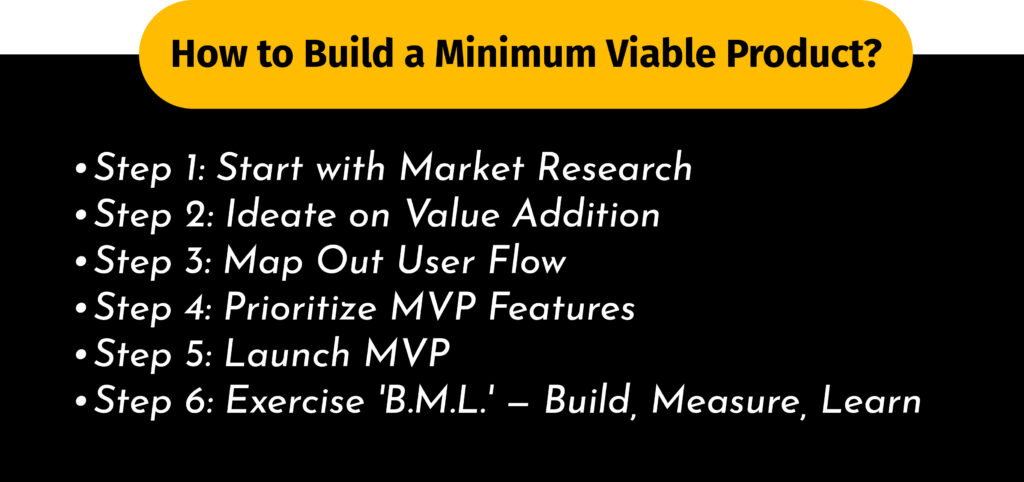This blog provides a foundational exploration of the initial customer attraction process, aiming to initiate your educational journey. After gaining a solid understanding of the basics, you can further explore them by engaging in additional research.
Embarking on a startup journey? Wondering how to attract venture capital and customers? The answer lies in building a compelling Minimum Viable Product (MVP). In this blog, we’ll explore the ins and outs of MVP development, uncovering the key steps, benefits, and pitfalls to avoid.
What is an MVP?
A Minimum Viable Product (MVP) is your product’s beta version, featuring essential functionalities to satisfy initial customers. It’s a strategic move to accelerate time to market, attract early adopters, and achieve product-market fit. Think of it as the “minimum essentials” that bridge the gap between your company’s offer and customer needs.
Why Build an MVP?
Building an MVP offers numerous advantages. It reduces initial investment, mitigates risks, and facilitates a trial round to adjust and enhance your idea. Not to mention, it’s a powerful tool for attracting investors and providing a tangible product to garner attention and funding.
How to Build a Minimum Viable Product?

The MVP’s purpose is clear: to launch a product quickly, validate an idea, and incorporate user feedback into future iterations. It’s a cost-effective, efficient way to find the right audience and fine-tune your product based on real-world experience.
Step 1: Start with Market Research
Ensure your idea aligns with market needs. Conduct surveys, analyze competitors, and gather information to increase your chances of success.
Step 2: Ideate on Value Addition
Define your product’s value proposition. Outline essential features that address users’ needs, focusing on simplicity and functionality.
Step 3: Map Out User Flow
Design the app from the user’s perspective, considering user flow, to ensure an intuitive and seamless experience.
Step 4: Prioritize MVP Features
Prioritize features based on user needs. Categorize them into high, medium, and low priority, creating a product backlog for step-by-step development.
Step 5: Launch MVP
Create a functional MVP prototype. Ensure it’s user-friendly, engaging, and meets customers’ needs.
Step 6: Exercise ‘B.M.L.’ — Build, Measure, Learn
Iterate through the build-measure-learn cycle. Test, gather feedback, and refine your product based on real user experiences.
Development Mistakes to Avoid
- Choosing the Wrong Problem to Solve
Define your product’s value by solving a genuine problem. Target a specific audience and ensure your solution resonates with their needs.
- Skipping the Prototype Phase
Prototyping is essential for visualizing the user experience. Aim for Goldilocks quality—neither too low nor too high.
- Targeting the Wrong Segment of Persona
Focus on genuine user feedback. Avoid irrelevant input and ensure your target audience aligns with potential customers.
- Inappropriate Development Method
Understand agile and waterfall approaches. Choose a method that aligns with your MVP development goals, emphasizing efficiency and flexibility.
- Confusion Between Qualitative and Quantitative Feedback
Balance qualitative and quantitative feedback. Triangulate data for a comprehensive understanding and informed decision-making.
Tips to Target the Right Market
1. Analyze the Competition
Conduct thorough competitor research. Understand their strengths, weaknesses, and target audience to position your MVP strategically.
2. Geographically Segment the Customer Base
Consider geographic factors when identifying your target market. Tailor your MVP to meet the specific needs of diverse locations.
3. Find the Motivation Behind a Purchase
Run surveys to understand customers’ motivations. Tailor your MVP positioning based on the insights gathered.
What Comes After MVP? Introducing MMP!
Once your MVP proves successful, transition to the Minimum Marketable Product (MMP). This is a product suitable for sales and marketing, allowing you to enter the market early and generate revenue while continuing development.
Marketing Your MMP
Prepare a solid business plan for marketing and sales. Focus on promoting and monetizing strategies to validate your software’s performance in the market.
Building a Minimum Viable Product is a strategic step in the software development process. It empowers startups to test ideas, gather real-world feedback, and attract investors. As you navigate the journey from MVP to MMP, prioritize user feedback, analyze data, and continually improve your product to meet market needs. Unleash the potential of your startup by unlocking the power of MVP development.
Ready to take the next step?
Pitch your MVP or MMP to us at pitch@bventure.com and let’s explore the possibilities together!